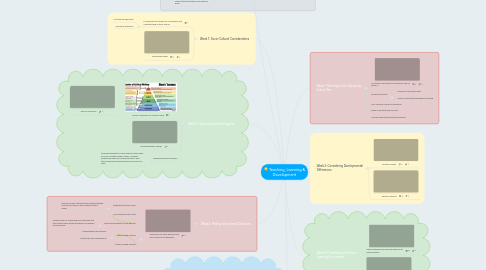
1. Week 4: Making Instructional Decisions
1.1. Technology to assist with learning and classroom management
1.1.1. Students teach the lesson
1.1.1.1. Each group has a differnet task, diferenentiated instruction based on their learning style or needs
1.1.2. Her classroom has a blog
1.1.3. Post their homework on her website
1.1.3.1. students were so interested and motivated that they posted other things that were not required by the teacher
1.1.4. Inquiry-based learning
1.1.4.1. "Hacking their own learning"
1.1.4.2. Create their own assessments
1.1.5. Probelm based learning
2. Week 5: Assessing Student Progress
2.1. Bloom's taxonomy of cognitive skills
2.1.1. Blooms taxonomy
2.2. Understanding by design
2.3. Assessing Student Progress
2.3.1. Assessing students in many different ways helps to cover a broader range of skills, motivate students and help you as the teacher to deal with overwhelming assessments and large class sizes.
3. Week 6: Individual Differences - Intellectual Abilities and Challenges
3.1. Concept of Inteligence
3.2. Models of intelligence
3.3. Special Education and the role intelligence play in its delivery
3.4. Controversial topics in special education
3.5. High-incidence exceptionalities
3.6. Inclusion and the role of the IEP
3.7. Cognitive styles, learning styles, and temperament
3.8. How the education system kills creativity
4. Week 7: Socio-Cultural Considerations
4.1. Considering the student as an individual and Understanding cultural frames
4.1.1. Multicultural education
4.1.2. Aboriginal education
4.2. Stereotype threat
5. Week 8: Standardized Achievement Tests
5.1. Arguments against standardized testing
5.1.1. There is a tendency to “teach to the test”, which results in narrowing of the curriculum.
5.1.2. The tests do not allow for linguistic or other cultural differences among students.
5.1.3. There is the potential for subgroups of students to become lost within the overall numbers.
5.1.4. Standardized testing leads to student disengagement.
5.1.5. The tests do not adequately assess 21st Century skills such as creativity, technological ability, problem solving, or critical thinking skills.
5.2. Arguments for standardized testing
5.2.1. The opportunity for comparison of educational outcomes across schools, provinces, or countries.
5.2.2. Results of standardized tests provide an opportunity to assess the strengths and weaknesses of the system.
5.2.3. Offering a means to assess accountability.
5.2.4. Provincial assessments provide a way to evaluate curricula and determine which schools/districts/regions are meeting goals.
6. Week 1: Planning for the Upcoming School Year
6.1. The future of education and what we can do about it.
6.2. Reflective Practice
6.2.1. Learners in the drivers seat
6.2.2. Video on reflective teaching and learning
